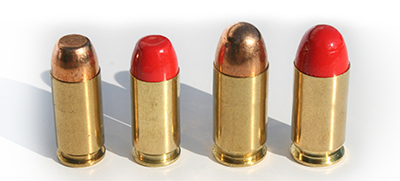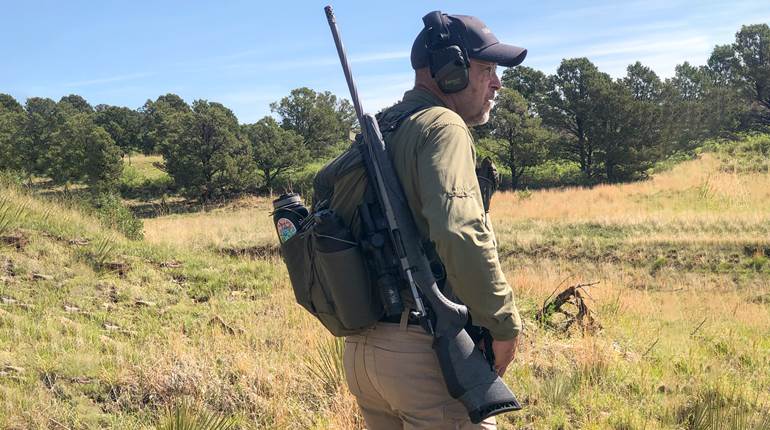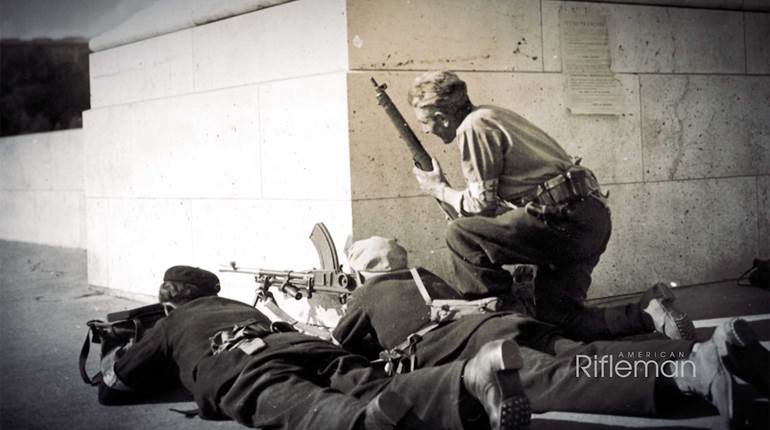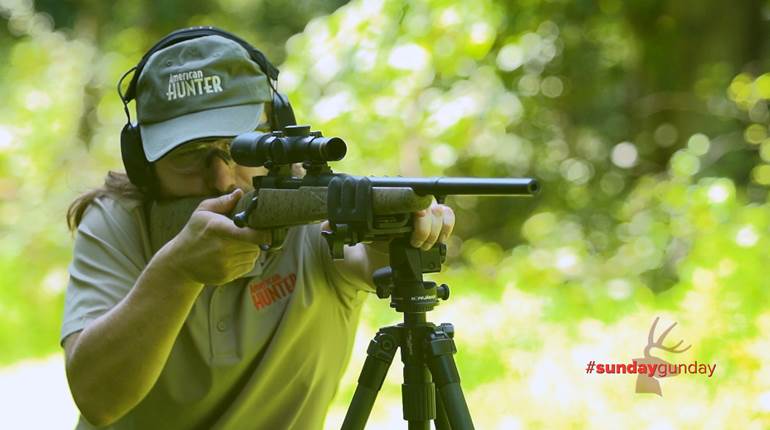
Handgun ammunition manufacturers put tremendous effort into creating fail-safe defensive loads; this is necessary because each individual round could be called upon to stop a deadly threat. From their efforts have emerged self-defense loads with superb round-to-round consistency and terminal performance. However, practice-type ammunition hasn’t received equitable attention (and thus upgrades) from many manufacturers. Federal Premium bucks the trend, though; in fact, the company has spent four years developing American Eagle Syntech, the new handgun “range” round evaluated here.

Syntech ammunition features total synthetic jackets (TSJ); that is, the lead-alloy core is totally covered by a thick, durable, red polymer coating, so no heavy metal is exposed. Bullet coatings are nothing new; some companies have (and still do) use molybdenum disulfide, while others created their own coatings or borrowed one from another industry. For example, Barnes employed a blue, dry-film lubricant on its X-Lubricated Coating (XLC) series bullets and Winchester still utilizes Lubalox (Black Oxide). Recently, several smaller “boutique” bullet companies have been applying polymer coatings to cast-lead handgun bullets with good results. Federal Cartridge Company’s original entrant (now discontinued) was Nyclad handgun ammunition, which featured lead-alloy bullets encapsulated by a nylon coating. Its experience with Nyclad aided the development of Syntech.
The benefits of a polymer jacket are many. First, since lead isn’t exposed to hot propellant gases, there’s no burn off to produce airborne lead. But the bullet is only one consideration. Traditional-type primers have lead, as well as other less-desirable components, that may contribute to airborne (and respirable) lead particles in indoor ranges. For American Eagle Syntech ammunition, Federal developed the new lead-free Catalyst primer, which is also touted as being both cleaner burning and more consistent.
Next, by replacing the gilding metal jacket of standard American Eagle full-metal-jacket loads with polymer, reduces friction as the latter material has increased lubricity over metal and eliminates metal-to-metal contact. This lessens heating during high-volume shooting sessions. How much so? According to Federal’s engineers, during testing of Syntech they found a 12 percent reduction in friction and 14 percent decrease in heat when compared to American Eagle jacketed loads in .45 ACP and 9 mm Luger. Because there’s no metal-to-metal contact, there’s bound to be less wear on the rifling, too. Although, given that standard pistol ammunition generates only modest velocities—especially in 230-gr. .45 ACP—the difference shouldn’t be mindboggling. Barrels can be quickly and easily replaced as well. The diminished friction does, however, enable higher velocities using less propellant, which then reduces perceived recoil.

There is a real difference with regard to cleaning. Whereas fouling from jacketed rounds and cast-bullet leading can be onerous to remove, Syntech’s polymer jacket eases cleanup since there is no metal-to-metal contact and the polymer doesn’t accumulate like the aforementioned materials. Moreover, the leadless Catalyst primer, held in reloadable brass cases, fully ignites the clean-burning propellants, so there’s less residue left in the bore for removal. The result is easier, less frequent cleaning of the handgun. Know that no special solvents or brushes are necessary to clean up after firing Syntech; standard equipment is fine for the task.
The polymer coating also helps in a way that you might not expect—safety. When shooting hard targets, such as steel, with full-metal-jacket ammunition there is splash back of lead and jacket fragments. When of sufficient size, the latter can be harmful to the shooter and those nearby. I know this because, when present on outdoor ranges, I have been struck and cut by sizable shards of jacket material. The absence of a metal jacket makes Syntech safer. How much so? After extensive testing, the company found, “Syntech produced 51 percent less total recoverable fragment weight than FMJs between 5 and 15 yds. of the target. It also resulted in 91 percent less weight in fragments traveling more than 15 yds. from the target, and at least 77 percent less fragments weighing more than 10 grs.”

To evaluate American Eagle Syntech ammunition, I gathered three handguns—a SIG Sauer P250 Subcompact in 9 mm Luger, a Smith & Wesson M&P40 in .40 S&W and a .45 ACP Ruger P90DC —and comparable American Eagle FMJ loads in .40 S&W and .45 ACP; none were on-hand in 9 mm Luger. Range work began with accuracy testing each Syntech load, followed by chronographing and then cleaning. I then accuracy tested the American Eagle FMJ loads and cleaned the pistols again for comparison purposes. These loads weren’t chronographed. I informally evaluated the loads for perceived recoil and barrel heat, too.
From a sandbag rest at 15 yds., five consecutive, five-shot groups with the 115-gr. 9 mm Luger Syntech load averaged an excellent 1.58". Despite the P250 having a 35⁄8" barrel, for 10 shots the average velocity was only 32 f.p.s. slower than the advertised velocity of 1130 f.p.s. The standard deviation was an impressive 8.
Testing for the .40 S&W and .45 ACP loads occurred at 25 yds. First came the .40 S&W, which, for five consecutive, five-shot groups with 165-gr. Syntech, averaged 2.78". For comparison, the 165-gr. American Eagle full-metal-jacket load had a mean of 3.05", so the Syntech load bested it slightly. From the M&P’s 4¼" barrel, 10 shots for Syntech averaged 1072 f.p.s.—with a 26 Sd—which is 72 f.p.s. higher than the published velocity.
The P90DC delivered good accuracy with 230-gr. Syntech, averaging 2.35" for 25 shots. There was a marked difference between it and the American Eagle FMJs, also in 230 gr., which had a five consecutive, five-shot group mean of 3.17". Flyers exaggerated several groups. Additionally, from the P90DC’s 4½" barrel the Syntech posted an average velocity of
765 f.p.s.—65 f.p.s slower than the advertised velocity. Keep in mind, too, that the FMJ load has a published velocity of 890 f.p.s. There were no failures to fire in more than 400 rounds expended.
After 50 rounds of Syntech, I cleaned each pistol using a jag and cotton patch soaked in Montana X-Treme Bore Solvent, followed by two dry patches. No bore brushes were used. There was the typical discoloration of the wet patch, but no evidence of plastic buildup/fouling in any of the guns. Subsequent to 50 rounds of American Eagle FMJs being fired through the
.40 S&W- and .45 ACP-chambered pistols, the above process was repeated. The results were similar; however, it’s worth noting that the patches from the .40 S&W Syntech test were somewhat cleaner than those of the FMJs, and vice-versa for the .45 ACP. I found identical results after 100-round sessions, too. Indeed, cleaning after using Syntech ammunition is an easy chore—exactly as touted.
During testing, I was once again reminded of the menaces of jacketed bullets and steel targets when a nearby shooter’s jacket shards rained down on the awning above us after pounding steel—probably 20 yds. distant. Using Syntech, there were no such occurrences; the bullets appeared to disintegrate upon impact, though we were aware that some small harmless fragments likely came a few yards back.
In shooting Syntech, the decrease in perceived recoil over standard FMJ loads is readily noticeable. That’s especially true of the 9 mm Luger and .45 ACP, which were slower than the comparable jacketed rounds. They were a pure joy to shoot, making the extended shooting session fun. And, despite the relatively warm temperatures, the barrels seemed to heat slowly. That observation is somewhat subjective, though.
Syntech is currently available in 115-gr., 9 mm Luger, 165-gr., .40 S&W, and 230-gr. ,.45 ACP for $19.95, $26.95, and $33.95, respectively, which is slightly more than the standard FMJs in 50-round boxes. There are a lot of benefits to be found in that additional cost, but only you, the shooter, can make that call. To me, it’s worth it.
Contact: Federal Cartridge Co., 900 Ehlen, Anoka, MN 55305; (800) 379-1732; federalpremium.com






































